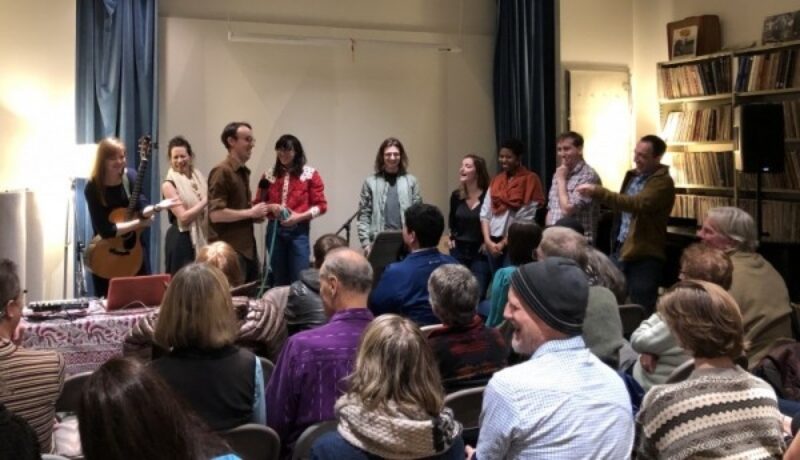Writing About Music About Writing
Written by TeenTix Press Corps Newsroom Writer Tova Gaster, and edited by Teen Editorial Staff Member Anya Shukla!

Spotify Wrapped screenshots plaster social media as the year comes to end, users’ music tastes consolidated into neat consumable packages. It’s possible I’m just salty that they called me out for listening to 50+ hours of the same artist (love you Y La Bamba), but Spotify, Apple Music, and similar streaming services are changing the way we engage with music—digitizing, isolating, and directing our listening via depersonalized algorithms. Jack Straw Cultural Center’s collaboration with the Bushwick Book Club offers a different way to engage with art: genre-blending musical collaboration, in real time.
The 12 Jack Straw writers for 2018 have been producing and sharing work all year through the Jack Straw Cultural Center in the University District, an organization dedicated to providing writers and musicians with recording experience. For their annual end-of-the-year event, Jack Straw partners with Bushwick Book Club, a collective of musicians that draw their inspiration from literary works, and pairs each writer with a musician whose job it is to create a song inspired by their writer’s work. These 12 songs span a vast range of musical styles and themes, showing the meandering transformation of an idea filtered through a different consciousness and medium.
As we create from a vulnerable personal place shaped by individual history, experiences, and values, the melding of the work of two artists coming from different backgrounds creates a fascinating commentary on the importance of art as a bridge.
Musician Nancy K. Dillon, for example, prefaced her performance by describing how she read the poetry of Natasha Kochicheril Moni through her own unique lense: Moni is of Indian and Dutch descent, and writes about how others often perceive her as white due to her pale skin. Dillon, on the other hand, was raised in South Dakota, and although white, often passed as Native American growing up due to her darker complexion. She interpreted their inverted experiences through the song “Skin Game,” which repeats the refrain: “Look at my skin, look within, inside out, outside in,” to a haunting looping melody. Although a simple sentiment (“we’re all human on the inside!”), the minor key complicated the lyrics, giving an ironic burnt flavor to Dillon’s delivery.
Similarly, musician Aaron Shay came to the work of Rachel Trignano with an appreciation for their shared Jewish heritage. A klezmer-bluegrass musician, Shay explored the diasporic tradition of both of those musical genres, writing the song “Abandoned Homes” for the banjo. Although Trignano was not there to hear him perform, Shay drew from their shared cultural legacy of immigration and tenement buildings, of history which is never as distant as it seems. Shay closed out the show by teaching the audience a Balkan clapping rhythm. Although we struggled to clap along in unfamiliar 5/4 time to his jaunty banjo strumming, the audience was brought into a final joyful act of collaboration.
In an alternate type of collaboration which yielded very different musical results, musician Coley Mixan and poet Corbin Louis met for the first time in person the day of the show. Corresponding purely over email, Nixon and Louis bonded over the contents of one of Louis’ poems: nostalgia, home, and the electric moment of connection with a stranger. With Mixan on vocals and electric guitar and Louis singing in a raspy shout from the piano bench, the unconventional sound came across as a raw fusion between the artists’ creative psyches, without the benefits of days of rehearsing or polish. The tension between their creative interpretations and contrasting vocal stylings gave the piece a vitality, and both artists were grinning throughout the song.
Many of the artists who created in close communication described the process as intensely vulnerable. There is always an intimacy in sharing writing, an assessment by the reader both of your technical ability and of the contents of your deepest self. To not only share that with another artist, but to leave yourself vulnerable to their own personal and creative interpretation is a huge leap of faith. Poet Meredith Clarke, who heard the song inspired by her work for the first time that day, said that it brought tears to her eyes.
In the same vein, musician JR Rhodes, inspired by the work of writer Sarah María Medina, sang in her song “My Beloved”: “I pray to feel tender without armor.” Deliberately opening yourself up to a channel of communication creates something so much more vital than the solitary act of listening to music alone on your phone, isolated in the tangle of your earbuds.
Getting out and seeing live music isn’t just entertainment; it’s a vital act of engaging with community and of honoring the work of artists, especially given the solitary digital alternative in which musicians are paid a fraction of a penny per listen. However, the live music scene for youth in Seattle is limited. Since the majority of music takes place at establishments which serve alcohol, minors are barred from most shows. This makes what Bushwick Book Club and Jack Straw provides feel all the more necessary. As poet Kamari Bright said, “I would say… [the experience] was dope.”
The full album of original music inspired by The Jack Straw Writers Anthology for 2018 is available to listen to HERE.
The Teen Editorial Staff is made up of 5 teens who curate the review portion of the TeenTix blog and manage the TeenTix Newsroom. More information about the Teen Editorial Staff can be found HERE.
The TeenTix Press Corps promotes critical thinking, communication, and information literacy through criticism and journalism practice for teens. For more information about the Press Corps program see HERE.


